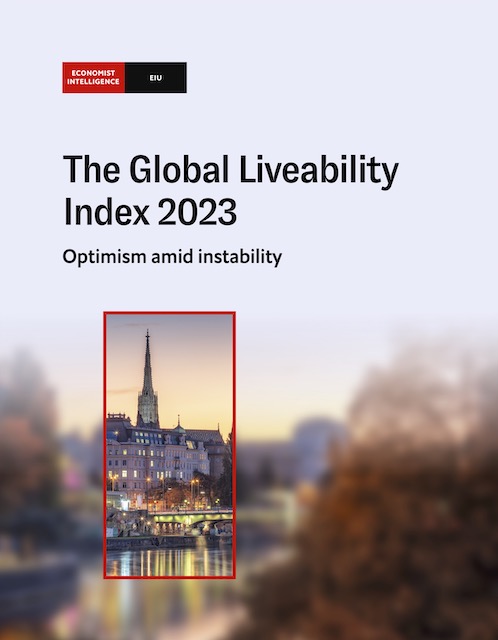North America’s most livable cities are also among the least affordable. At least, that’s my conclusion from the Economist‘s 2023 Livability Index. According to this index, Vancouver BC, which Wendell Cox ranks as the least-affordable housing market in North America, is also the continent’s most livable city.
Click image to download a copy of this report.
Other cities that the Economist ranks high on the livability list include Boston, Honolulu, Miami, Montreal, Portland, Toronto, San Francisco, Seattle, and Washington, all of which are rated unaffordable (median home prices are at least five times median household incomes) by Cox. The only city that is truly affordable and, according to the Economist, livable is Pittsburgh, and it’s so livable that its population has been shrinking for 70 years. Admittedly, the Economist also counts Atlanta, Calgary, and Minneapolis as livable, regions that Cox says are marginally affordable (home prices 4 to 5 times incomes).
The Economist bases its livability index on five factors: stability, healthcare, culture & environment, education, and infrastructure. The stability of Portland, San Francisco, and Seattle is pretty questionable at the moment, but the big question is why isn’t housing affordability one of the factors in the Economist‘s livability index.
One possible answer is that the Economist‘s list is made for people who are so rich that they don’t care about housing prices. Another possible answer is that the Economist is influenced by urban planners who believe higher housing prices are a good thing because they lead people to live in denser cities, which they regard (without much justification) as being more livable.
My own livability index doesn’t include any cities — I find living in a town of 3,000 people to be marginal — but if it did, it would emphasize low-density cities that have exciting cultures, are close to attractive outdoor recreation opportunities, and enjoy affordable housing markets. Albuquerque would be at the top of my list followed by San Antonio, and perhaps Tucson. Those are only my personal preferences, but whatever criteria you use, I suspect affordability will be on your list.









Quick map image of any square blocks in major cities, one-third of all land is dedicated automotive infrastructure. In Sun Belt cities its practically half. 50 years ago living in city was a fairly tolerable activity.
Now we live in society where parking is free and housing is expensive and we wonder why we have a problem…..
Where is this place where parking is free and housing is expensive?
“An everyman is described with the intent that most audience members can readily identify with him.
Although the everyman may face the same difficulties that a hero might, archetypal heroes react rapidly and vigorously by manifest action, whereas an everyman typically avoids engagement or reacts ambivalently, until the situation, growing dire, demands effective reaction to avert disaster.”
https://en.wikipedia.org/wiki/Everyman
Things are looking dire for the everymen (and women) in charge of cities like San Francisco and Seattle …
”
The Economist bases its livability index on five factors: stability, healthcare, culture & environment, education, and infrastructure.
”
How does one measure culture?
“My own livability index doesn’t include any cities — I find living in a town of 3,000 people to be marginal”
I struggle to find comfort in neighborhoods due to my misophonia; various noises, such as barking dogs and car alarms, trigger it. I also value my privacy, which I found compromised by intrusive neighbors in the past.
The rural life I grew up with suits me better, although popular or proximal areas to cities don’t work for me either. My recent experience living near a busy highway with excessive traffic, speeding vehicles, and drunken driving was not pleasant, to say the least.
Living in a less developed area with wildlife close by has been a better experience, though it has its drawbacks too. Proximity to a busy county road and neighbors with a lack of respect for private property remain an issue.
I’m planning to find a homestead in places like North Central Washington, Wyoming, Montana, Idaho, or Utah, preferably a half-hour drive from a small town. But the pricing is a challenge due to the “West tax”. Land in the West, with mountains and forests, is pricier than land in the Midwest. For the same price, I could acquire much more land in the Midwest than in the Western states I’m considering.
Culture: lots of brown people. Minimal crime
My guess is that education is measured the same way as culture. If there are some schools for the rich to send their children and maybe a very expensive college that provides some “culture”, they will measure education as being fine.
The poor children in public schools may be as illiterate as ever but that is under the Economist’s radar. Also, if the public school unions make the city pay huge sums for not educating the poor, the Economist will give high grades for education because a lot of money is spent-not because children are benefiting from those funds.